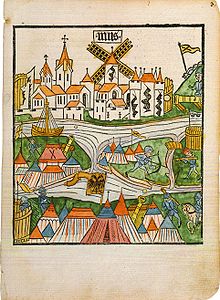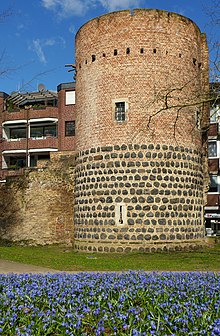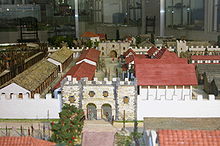Neuss
This is the sighted version that was marked on May 19, 2021. There are 2 pending changes that still need to be sighted.
![]()
This article is about the German city of Neuss; for other meanings, see Neuß.
Neuss (until 1968 officially spelled Neuß, in the regional dialect Nüss as well as in Latin Novaesium) is a large city in North Rhine-Westphalia. It is located on the left bank of the Lower Rhine on the opposite side of Düsseldorf and, with almost 160,000 inhabitants, is Germany's largest city belonging to a district and, as a medium-sized centre, also the largest city in the Rhine district of Neuss. The city is especially known for its Roman past, the Rhine harbour and the Neusser Bürger-Schützenfest. In 1984 it celebrated its 2000-year anniversary and is thus one of the oldest cities in Germany.
Geography
Neuss is located on the left bank of the Lower Rhine on a low terrace opposite Düsseldorf, at the mouth of the Erft into the Rhine. The highest elevation in the city area is near the district of Holzheim and is 67.5 m, the lowest point is in the area of the southern city limits and is 30 m above sea level. The largest extension of the city area is 13.2 km in north-south direction and 12.8 km in west-east direction. Even though Neuss is basically located at the eastern edge of the Rhine district of Neuss, the geographical centre of the district is also still within the city area of Neuss (near Gut Hombroich).
There are a number of nature reserves and landscape conservation areas, see List of nature reserves in the Rhine District of Neuss and List of landscape conservation areas in the Rhine District of Neuss.
Neighboring communities
The following cities and municipalities border the city of Neuss. They are named clockwise, starting in the east:
Düsseldorf (independent city) as well as Dormagen, Grevenbroich, Korschenbroich, Kaarst and Meerbusch (all Rhein-Kreis Neuss)
City breakdown
In the area of the city of Neuss the following four city districts are formed:
- City district I: Neuss-Holzheim
- City district II: Neuss-Norf
- City district III: Neuss-Rosellen
- City district IV: Neuss-Uedesheim
The urban area is further divided into Statistical Districts. These are numbered consecutively and have a name:
1 Innenstadt, 2 Dreikönigenviertel, 3 Hafengebiet, 4 Hammfeld, 5 Augustinusviertel, 6 Gnadental, 7 Grimlinghausen, 8 Uedesheim, 9 Weckhoven, 10 Erfttal, 11 Selikum, 12 Reuschenberg, 13 Pomona, 14 Stadionviertel, 15 Westfeld, 16 Morgensternsheide, 17 Furth-Süd, 18 Furth-Mitte, 19 Furth-Nord, 20 Weißenberg, 21 Vogelsang, 22 Barbaraviertel, 23 Holzheim, 24 Grefrath, 25 Hoisten, 26 Speck / Wehl / Helpenstein, 27 Norf, 28 Rosellen.
Some districts include separately located residential places with their own names, some of which coincide with the district: Allerheiligen, Bettikum, Derikum, Dirkes, Elvekum, Erfttal Ost, Erfttal West, Gier, Grefrath, Gruissem-Ost, Helpenstein, Am Kreitz, Kuckhof, Lanzerath, Löveling, Minkel, Rheinparkcenter, Röckrath, Rosellerheide/Neuenbaum, Schlicherum, Speck, Stüttgen, Wehl and Rott.
History
Roman period
Novaesium
→ Main article: Novaesium
Neuss is one of the oldest cities in Germany. As early as 16 BC, Roman soldiers built a fortification of wood and earth at the mouth of the Erft into the Rhine, about 2.5 km southeast of today's old town. The site, which was presumably already the location of a predecessor settlement of Celto-Germanic origin, was strategically chosen, since on the one hand it lay at the end of a Roman trunk road that led through Gaul conquered by Caesar from Lyon via Trier and Zülpich to the Rhine, and on the other hand it offered convenient access to the waterways of the Rhine, Erft, Lippe, Ruhr and Wupper. Further army camps at this location, probably also used only seasonally, followed each other (so-called "camps A to F"). Among others, Legio XIX and Legio XX Valeria Victrix may have been stationed here temporarily.
Around the middle of the first century AD, Roman soldiers, including those of Legio VI, built a stone legionary camp for the first time near the mouth of the Erft in Neuss-Grimlinghausen, also known as the "Koenen Camp" after its discoverer, the archaeologist Constantin Koenen. During the second half of the first century AD, an entire legion with almost 6,500 soldiers was permanently stationed in the fort. A large diorama of the fort and the surrounding civilian settlement, designed by H.-J. Graul according to scientific findings, can be found today in the open-air museum Roscheider Hof.
After the VI. legion, which was last stationed in the "Koenen camp", had been transferred to Xanten around 100 AD. Legion had been transferred to Xanten around 100 AD, a stone auxiliary camp was built on its site at the beginning of the 2nd century, which provided space for a garrison of about 600 men. When, at the end of the 3rd century, the Roman border defence had to be reorganised in response to the increased raids by Frankish troops on Roman territory, the auxiliary camp at the mouth of the Erft was abandoned.
Civil settlement
Extensive burial grounds and a camp suburb (canabae legionis) developed around the military camp, where the families of the soldiers lived, but also merchants, innkeepers and military craftsmen worked. This camp suburb and its burial ground developed into a civilian settlement ("vicus"), from which today's Neuss grew in the course of the centuries.
Early Middle Ages
During his excavations at and around St. Quirin's in 1963, Hugo Borger also discovered three Frankish graves from the time around 500 A.D. They testify that the early medieval settlement in Neuss was directly linked to antiquity. Finds from the 8th/9th century were made at the Obertor and at the Marienkirche.
One of the first documentary evidence for Neuss in the early Middle Ages dates back to 877, when King Louis the Younger granted the monastery of Werden exemption from customs duties at the customs site in Neuss, which concerned a market customs duty. Even at the beginning of the High Middle Ages, there is evidence of a Frankish castle or imperial court in the current city area of Neuss, as the short-term presence of German kings and emperors was frequently documented there. Neuss belonged to the Nievenheim or Neusser Gau. For example, a document of Emperor Heinrich II dates back to 18 June 1023. which was issued during his presence in "Nuiss". Further documents are available from Emperor Konrad II. (1024 in Niuhsse) and Emperor Henry IV (1062 in Niusse). The secular sovereignty over the territory of Neuss by the archbishops of Cologne can first be proven under Archbishop Anno II at the beginning of the second half of the 11th century. Before that, the Counts of Cleves briefly had sovereign rights in Neuss, as a church was built by them in the village, which was later rebuilt and extended to become the Quirinus Minster. Bailiffs of Neuss at this time were the Counts of Kessel. In the second half of the 10th century, a Benedictine convent was built next to the church, donated by a family of high nobility. It was probably at this time that the relics of St. Quirinus of Neuss, the patron saint of this church, were transferred to Neuss.
History Middle Ages and Modern Times
Becoming a city
Under the archbishops of Cologne, Neuss developed into a trading town. The earliest documentary evidence that Neuss had become a customs site for the Rhine duty under the Cologne archbishops dates from 1138. In a document, Archbishop Arnold I of Cologne exempted the Bedburg Marienstift from paying this Rhine duty. As early as 1190, Neuss was officially designated as a town for the first time, and Henry VI confirmed duty-free status for Kaiserswerth to the archbishopric towns of Cologne and Neuss.
Around 1200, the great city wall with several gates was built. The wall was at first constructed as a cast-iron wall about one metre thick, consisting of two tufa shells in whose interstices pebbles and trass lime had been filled; they were subsequently further extended. The gates were: Obertor, Niedertor, Rheintor, Hessentor, Hamtor and Zolltor. The towers include: Blood Tower and Windmill Tower. The moats of the city fortifications include the Erftmühlengraben.
In 1209, Master Wolbero laid the foundation stone of the Quirinus Minster using previous buildings. In 1222 Archbishop Philipp I confirmed the city's privileges. By the middle of the 13th century, Neuss' importance as a trading town on the Lower Rhine had increased further, and it became a member of the Hanseatic League. Trade was further strengthened by the freedom from customs duties granted to the people of Neuss in Denmark by the Danish King Erik V in 1270.
In addition, Neuss tried to limit its dependence on the archbishopric of Cologne and strove for imperial immediacy. In 1254, permission was granted to demolish the archbishopric's fortified castle in the city. In addition, the city received the promise that no new "fortress" would be rebuilt without the consent of Neuss. This independence from Arch Cologne was further supplemented in 1259 by Archbishop Konrad von Hochstaden. He granted the people of Neuss the election and formation of a town council with twelve to fourteen aldermen. Furthermore, the city's statutes were to be freely drafted.
In 1271 the Counts of Kessel sold their bailiwick of Neuss to the Archbishop of Cologne, Engelbert II.
Via King Rudolf of Habsburg, the city received imperial immediacy in the last quarter of the 13th century. However, since Neuss granted protection and residence to the impostor Tile Kolup as Emperor Frederick II, the imperial immediacy was revoked by Rudolf of Habsburg after a short time and the city was again subordinated to the Archbishop of Cologne. When confirming the right to vote and the conditions of 1259, in 1310 the archbishop Heinrich II restricted them by adding that the election of the city councillors had to be confirmed by Arch Cologne.
As the tensions between the city of Neuss and Arch Cologne regarding the extent of the city's freedoms continued, the new Archbishop Frederick III decided immediately after his election in November 1370 to transfer the Rhine customs from Neuss to the small Electorate of Cologne village of Zons up the Rhine. Here no problems were to be expected due to resistance from the inhabitants. As early as August 1372, the customs office in Zons was opened and the one in Neuss was closed. The protest of the people of Neuss against the relocation of the customs post was rejected by the German King Wenceslas with the approval of this action by the Electorate of Cologne on July 6, 1376.
In 1474/75 the town withstood the siege of Neuss by Charles the Bold for almost a year. As a reward, Emperor Friedrich III. As a reward, Emperor Frederick III granted Neuss the privilege of minting, the privilege of red watch, the rights of a Hanseatic city and a new coat of arms. In addition, the city's charter and statutes with the free election of the council and aldermen, which had been disputed in the past between the archbishops of Cologne and the city, were confirmed. After the end of the siege, the extensive war damage was immediately repaired and the city came to considerable prosperity.
In 1585, during the Cologne War, Count Adolf von Neuenahr, fighting on the side of Gebhard I of Waldburg, conquered the city of Neuss and destroyed a number of smaller castles and fortified farms in the Neuss hinterland. In July 1586 the Flanders army under the governor of the Habsburg Netherlands Alessandro Farnese laid siege to Neuss. The town was defended by a garrison of around 1,600 soldiers led by Hermann Friedrich von Pelden. On July 26, 1586, Neuss was captured and then looted and set on fire. The entire garrison was killed. In addition, about 3,000 of about 4,500 inhabitants of the town were also murdered. Only eight houses were spared from the fire.
In the course of the Thirty Years' War, Hessian troops conquered Neuss in January 1642. The city was to remain occupied beyond the end of the war and only regained its independence on 2 July 1651.
In 1635 Hester Jonas became a victim of the witch trials in Neuss.
19th century
In 1794, during the First Coalition War, French troops occupied Neuss. They immediately set up several artillery positions on the Rhine. Remains of such an artillery position can still be seen today in the Uedesheimer Rheinbogen between Uedesheim and the Fleher Brücke. They are known as the "Alte Batterie". During the French period, which lasted from 1794 to 1813, construction work was carried out in Neuss on the Nordkanal, which was intended to create a navigable link between the Rhine and the Meuse. This was intended to circumvent the river duties down the Rhine. The canal was not completed. During the wars of liberation, Prussian troops crossed the Rhine at Neuss on 2 December 1813 and drove out the French occupation.
In 1815 Neuss became Prussian according to the Final Act of the Congress of Vienna and in 1816 the seat of a district. In the 19th century, the city experienced a new economic upswing, which was essentially supported by the construction of the railway (among other things, connection to the railway network on the right bank of the Rhine through the Hammer railway bridge (completed in 1870) across the Rhine to Düsseldorf-Bilk) and the Rhine harbour.
District-free city
In 1913 Neuss left the district of Neuß and became a district-free city. In 1929, the remaining parts of the districts of Neuß and Grevenbroich were united to form the new district of Grevenbroich-Neuß (later the district of Grevenbroich). During the November pogroms of 1938, the Neuss synagogue was set on fire and Jewish businesses and homes were demolished. Subsequently, about 130 Jews were deported to concentration camps until 1942.
See also: List of Stolpersteine in Neuss
During the Second World War, Neuss suffered 136 air raids from 1940 onwards; as in many other Rhenish cities, large parts of the historic old town were destroyed by British air raids. The first major attack took place in the night of 31 July to 1 August 1942; it claimed 279 lives and left 12,000 homeless.
In 1944, Neuss experienced six more major attacks. This resulted in 537 dead and 544 injured as well as 833 destroyed houses. The Quirinusmünster was hit by an explosive bomb and very badly damaged. Destroyed were the Preußenstraße Municipal Hospital, the Kamillushaus and the Alexian Hospital with the churches, the Immaculata and Marienberg churches, Josephskloster and Annastift, and on 31 December also the historic town hall.
American troops - the 330th Infantry Regiment of the 83rd US Infantry Division - occupied Neuss and the city areas of Düsseldorf on the left bank of the Rhine as part of Operation Grenade on March 1 and 2, 1945.
In 1968 the spelling was changed from "Neuß" to "Neuss".
Neuss district
With the Düsseldorf Act in the course of the territorial reform of 1975, some municipalities and localities surrounding Neuss (e.g. Holzheim, Norf and Rosellen) were incorporated (see also Incorporations) and the independent city of Neuss was united with the district of Grevenbroich to form the new district of Neuss (since 2003 Rhein-Kreis Neuss). Neuss was given the status of "Große kreisangehörige Stadt" and became the seat of the new district, although large parts of the district administration are located in Grevenbroich. In 1984 Neuss celebrated its 2000th anniversary, for which (with the permission of the French rights holders) a comic special Asterix in Novaesium was published.
Incorporations
In the course of history, the following municipalities or parts of municipalities were incorporated into the city of Neuss: At the beginning of the 20th century parts of Heerdt, Büderich and Kaarst, in 1929 Grimlinghausen, Uedesheim and Weckhoven as well as on 1 January 1975 Grefrath (municipality of Holzheim), Holzheim, Hoisten (municipality of Neukirchen), Norf, Rosellen and Speck (municipality of Neukirchen) as well as further parts of Kaarst.
Population development
In 1963, the city's population exceeded 100,000, making it a major city. On 1 January 1975, the population of Neuss increased by 30,000 people to 148,000 due to the incorporation of several towns. At the end of December 2012, 151,486 people lived in Neuss with their main residence, according to an update by the State Office for Information and Technology of North Rhine-Westphalia, and the trend is still rising. The proportion of foreigners was 12.0 %.
The following overview shows the population figures according to the respective territorial status. Up to 1833, these are mostly estimates, thereafter census results (¹) or official updates of the respective statistical offices or the municipal administration itself. From 1843 onwards, the data refer to the "resident population", from 1925 onwards to the resident population and since 1987 to the "population at the place of principal residence". Before 1843, the number of inhabitants was determined according to non-uniform survey methods.
|
|
|
|
1 Census result

Population development of Neuss from 1771 to 2017 according to the adjacent table

Siege of Neuss 1474-1475

Blood Tower - Neuss

Upper gate - Neuss

Area of the former Roman legionary camp

Diorama of the Roman fort of Neuss in the pewter figure department of the open-air museum Roscheider Hof
Search within the encyclopedia